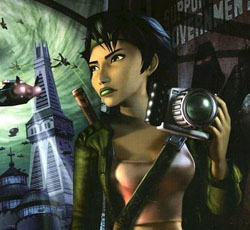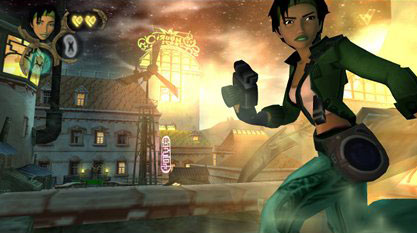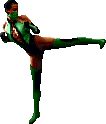It all started when I made this weird, rambling post complaining about Samus Aran’s characterization in Other Msome crappy new game I hadn’t even played. Basically, I feel like there aren’t enough awesome female protagonists in video games. I took an inventory of every console game I’ve purchased in the last ten years and made a list, and was shocked to find that there have only been five really memorable heroines who aren’t sultry sex kittens and who don’t have to share their spotlight with some dude. So I figured I’d blog about them! There were a lot of also-rans and not-quite-greats as well, so I’ll be covering them as well. Thanks very much for reading!
Video Game Heroines Series
Week One: Supplanted Heroines
Week Two: Great Gaming Heroines #5: Ashley Robbins
Week Three: Shantae vs. Shanoa — An Action Girl Case Study
Week Four: Great Gaming Heroines #4: Commander Shepard
Week Five: The Off-the-Shelf Heroine
—
#3: Jade
(Beyond Good & Evil, 2003, PC/GCN/PS2/Xbox)
At first glance it seems a little too on-the-nose. A woman with green clothes, green eyes, a green headband and green lipstick… named Jade? That’s not a unique character. That’s a palette-swap someone threw together fifteen minutes before a deadline.
Beyond Good & Evil is one of those rare games that really is greater than the sum of its parts. It’s a combat/stealth/puzzle-based action game with tedious combat, trial-and-error stealth and puzzles which only rarely aspire to be more engaging than “find the key that goes with this door”.
Not to mention the hair-pulling vehicle sections. And the mini-games. Dear sweet Jesus the mini-games.
So to rephrase that first statement a bit: Beyond Good & Evil is one of those rare games where the setting, characters and ambience really, truly do make the game. The gameplay isn’t bad, you understand. It’s just not the kind of good we typically associate with good games. No, what makes BG&E really sizzle is its colorful, imaginative world and its vivid, often bizarre inhabitants.
And its heroine, Jade. She is, with good reason, the most memorable aspect of the game.

Right on the box art, BG&E begins to tell Jade’s story: though she looks to inhabit the traditional dystopian alien universe, she’s holding a camera, not a gun. That humble camera does a great deal to carry the weight of the game, as it defines not only the protagonist but also the underlying theme of investigation that makes her adventure so unique. Jade’s camera isn’t just a gimmick they added as a bullet point on the back of the box. It’s her primary weapon, in a way Link’s sword or Samus’s plasma beam simply aren’t. Most every climactic scene in the story occurs because of a carefully planned snapshot, sometimes taken while dangling from a ledge or fleeing across a collapsing catwalk.
Jade uses photography as a means to fund the orphanage she runs out of a lighthouse on the idyllic planet of Hillys. Idyllic, that is, until it comes under attack by Lovecraftian aliens and the corrupt, dictatorial government shuts off their emergency force fields. After defending their lighthouse by the skin of their teeth, Jade and her porcine uncle Pey’j realize they can no longer keep their kids safe from the dangers of the world by trying to remain outside of it. In searching for a way to re-establish some sense of security (both the financial kind and the “not exploded by spacemen” kind), Jade ends up as an investigative journalist for an underground resistance network. Her job: infiltrate a variety of government facilities, prove the link between those facilities and the alien attacks, and bring this proof to the populace so as to incite revolution.
Oh, and if you could please take pictures of every furry little critter you encounter along the way, that would be just peachy.
Jade’s initial role, therefore, is that of a mother figure; her children are in danger and she will stomp the world to dust if that’s what it takes to protect them. Which is pretty rare in the realm of video games, isn’t it? There are lots of daughter figures out there, plenty of big sisters, countless love interests. The concept of a mother who only bears her teeth when her young are threatened is one that hasn’t really been explored in our medium… probably because it doesn’t play as well to the male 18-30 demographic as scantily clad virginal types do.
A fair amount of this comes across in Jade’s interactions with her own parental figure, Pey’j. At the beginning of the game Jade and Pey’j are portrayed as partners. They’ve seen and endured practically everything together, and have built a strong mutual respect. You could get the impression, in those early scenes, that Pey’j is simply Jade’s comic relief sidekick. Once he’s taken away from her, though, she discovers the extent to which Pey’j secretly dotes on her. He raised her, just as she is raising her orphans, and it becomes clear just how difficult it’s been for him to see her come into her own.
That story, the one where Pey’j plays the part of the protective, overbearing parent, would have been enough to carry both his and Jade’s character development through an entire game. But then Jade would just be the same sheltered daughter we’ve seen dozens of times before. (Quick — how many princesses have you helped escape from their castles over the years?)
Which isn’t to say that Jade isn’t in need of some guidance. Though she is fearless, and can hold her own in a fight, she’s still pretty new to this whole adventure thing. This naivety becomes apparent fairly early on, as she and Pey’j work their way through the first of the game’s major dungeons. While she’s perfectly capable of handling the situation it’s also clear she’s a little out of her element. This is usually the part in the story where the hero come along, shining and reliable, or where a greybearded old sage would impart upon her some worldly wisdom.
But exactly the opposite happens. Instead of Pey’j stepping up and sharing with Jade the wealth of his experience, he is whisked away by the bad guys. Worse, there seems to be no way of mounting a rescue… and worse still, there is no one to turn to for aid. At the outset Jade is very much a go-getter, always willing to take charge of a situation. But when the stakes are for real and everyone is looking to her, Jade is forced to do that last bit of growing up pretty quickly.
Jade has an emotional meltdown right around the time everything she was fighting for is destroyed, despite all her best efforts. She bounces back quickly — perhaps a little too quickly — but the scene is still pivotal to Jade’s character development. Identifying her failure and pushing through it are not easy tasks. Even the unusually peppy Double H doesn’t seem to buy his own pep talk. Hitting rock bottom, and then walking on her own legs out of the rubble, is Jade’s real triumph.

Jade is equally unique from a gameplay standpoint. Though her enemies come armed with the kind of artillery usually reserved for Godzilla attacks, Jade wouldn’t know what to do with a gun even if she picked one up. Instead she fights by using a combination of a stick and her razor-sharp wit. (And later, a NERF disc-launcher.) Enemy encounters in BG&E rarely involve firefights, and treating Jade like a commando is a good way to see the Game Over screen. Jade is lithe and athletic, but not in the sense that she is a water dancing karate master. Jade’s agility doesn’t allow her to enter bullet time or jump-kick across swarms of soldiers, but it does let her squeeze up into a shadowy rafter from which she can pick her opponents off one-by-one, Batman-style. Where most characters with her physique are cast as badasses despite their small stature, Jade makes her size work for her by getting into place she otherwise wouldn’t be able to go, and waging her war from the shadows.
In fact, the most climactic action sequence in the game involves Jade actively fleeing from enemies she knows she can’t take head-on. It’s a smart hero indeed that knows how to pick her battles.
Cast in an uncommon role, wich an unusual skillset, and lacking the emotional support network usually afforded to help adventure heroes through their tribulations… these are the things that make Jade such a spectacular character. You will spend your time with Beyond Good & Evil marvelling at this vaguely Asian-looking girl with bright green lipstick, and how she doesn’t quite do things the same way your last action game hero did. And hey, her visually striking design and excellent voice acting doesn’t hurt either. Neither does the fact that the setting is so imaginative that you’ll want to point that camera everywhere.
Now I’m just crossing my fingers that sequel actually comes out someday. But hey, it worked for Shantae.


I experienced this game for the first time this year and playing it really made me wish I had gotten it sooner.
It also made me want more. Which is weird. Like you say at the start there’s lots of stuff in this game that would infuriate me in other titles (I absolutely hated the racing, and hell, one of the dungeons REQUIRES you to race to gain access), but that’s all easily forgotten once you look at the other parts of the game.
And we need more heroines like Jade. I really hope that Ubisoft won’t take the low road with the sequel and over sexualize/damselize her.